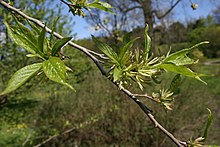Eucommia
| Eucommia | |
|---|---|

| |
| Eucommia ulmoidesfoliage and flowers. | |
| Scientific classification | |
| Kingdom: | Plantae |
| Clade: | Tracheophytes |
| Clade: | Angiosperms |
| Clade: | Eudicots |
| Clade: | Asterids |
| Order: | Garryales |
| Family: | Eucommiaceae Engl.[2] |
| Genus: | Eucommia Oliv.[1] |
| Species | |
| |
Eucommiais a genus of smalltreesnownativetoChina,with a fossil record that shows a much wider distribution. The single living species,Eucommia ulmoides,isnear threatenedin the wild, but is widely cultivated in China for itsbark,and is highly valued inherbologysuch astraditional Chinese medicine.[4]
Description
[edit]ModernEucommiatrees grow to about 15 m tall. The leaves aredeciduous,arranged alternately, simpleovatewith anacuminatetip, 8–16 cm (3.1–6.3 in) long, and with a serrated margin. If a leaf is torn across, strands oflatexexude from the leaf veins and solidify intorubberand hold the two parts of the leaf together. It flowers from March to May with theflowersbeing inconspicuous, small, and greenish. Thefruitsripen between June and November and are a wingedsamarawith oneseed,very similar to anelmsamara in appearance. The modern fruits are 2–3 cm (0.79–1.18 in) long and 1–2 cm (0.39–0.79 in) broad, while fruits of the extinct species range up to 21 millimetres (0.83 in) long.[4]
Eucommiaisdioecious,with separate male and female plants.[5]
Taxonomy
[edit]Eucommiais the sole member of the family Eucommiaceae, and was formerly considered to be a separate order, the Eucommiales. The modern species is sometimes known as the "hard rubber tree",[4]"Gutta-percha tree" or "Chinese rubber tree", but is not related to either the trueGutta-perchatree of southeastern Asia, nor to the South Americanrubber tree.
- Eucommia
- †Eucommia constans(Miocene-Pliocene; Mexico)
- †Eucommia eocenica(Middle Eocene; Mississippi Embayment)
- †Eucommia europaea(Oligocene; Europe)
- †Eucommia jeffersonensis(latest Eocene; Oregon)
- †Eucommia montana(Early-Late Eocene; western North America)
- †Eucommia rolandii(Early-Middle Eocene; Mississippi and British Columbia)
- Eucommia ulmoides(Living, central-eastern China)
Medicinal Use
[edit]Eucommia tea has been shown to somewhat lower blood pressure.[6]It has been used and sold for a various other things. Research appears to be somewhat limited.
Distribution
[edit]E. ulmoidesis native to forest areas on hills and mountains of the provinces in central and eastern China, though it has been suggested that the species is extinct in the wild.[4]E. ulmoidesis also occasionally planted inbotanical gardensand othergardensinEurope,North America,and elsewhere, being of interest as the only cold-tolerant (to at least -30 °C) rubber-producing tree.Fossilspecies ofEucommiahave been found in 10- to 35-million-year-oldbrown coaldeposits in centralEurope,[4]in numerous fossil sites in Asia,[4]and five different fossil species have been described fromNorth America,indicating the genus had a much wider range in the past.[4]
References
[edit]- ^"Eucommia".International Plant Names Index(IPNI).Royal Botanic Gardens, Kew;Harvard University Herbaria&Libraries;Australian National Botanic Gardens.Retrieved9 September2013.
- ^Angiosperm Phylogeny Group (2009)."An update of the Angiosperm Phylogeny Group classification for the orders and families of flowering plants: APG III".Botanical Journal of the Linnean Society.161(2): 105–121.doi:10.1111/j.1095-8339.2009.00996.x.hdl:10654/18083.
- ^Rivers, M.C. (2018)."Eucommia ulmoides".IUCN Red List of Threatened Species.2018:e.T31280A130694949.doi:10.2305/IUCN.UK.2018-2.RLTS.T31280A130694949.en.Retrieved18 January2024.
- ^abcdefgCall, V.B.; Dilcher, D.L. (1997). "The fossil record ofEucommia(Eucommiaceae) in North America ".American Journal of Botany.84(6): 798–814.doi:10.2307/2445816.JSTOR2445816.PMID21708632.S2CID20464075.
- ^"Eucommiaceae".Flora of China.9 March 2021 – via eFloras.org,Missouri Botanical Garden,St. Louis, MO &Harvard University Herbaria,Cambridge, MA.
- ^Greenway, Frank; Liu, Zhijun; Yu, Ying; Gupta, Alok (2011-12-16)."A clinical trial testing the safety and efficacy of a standardized Eucommia ulmoides Oliver bark extract to treat hypertension".Alternative Medicine Review: A Journal of Clinical Therapeutic.16(4): 338–347.ISSN1089-5159.PMID22214253.
External links
[edit]![]() Data related toEucommiaat Wikispecies
Data related toEucommiaat Wikispecies

